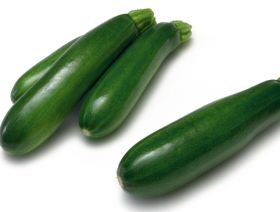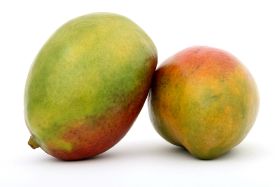
The FPJ Big 50 Products ranks the 50 best-selling fresh fruit and vegetable products by sales value, using Kantar Worldpanel data for the 52 w/e 21 May 2017.
36. Courgettes

Downward movement in retail prices
Value: £68m (-4.9%) Volume: 35.2m kg (+5.2%)
A non-mover in this year’s Big 50 list, courgettes have experienced some deflation recently as retailers have begun to move on price. This has been made possible in some cases thanks to volume growth allowing greater efficiencies on the supply side, as well as retailers taking lower margins, says managing director of Southern England Farms, Greville Richards.
“It’s been a bumper year with massive volumes going out the door. We can do 300 tonnes a week on a peak week,” he says, adding that growing conditions have been challenging in some parts of the country. “I think the supply base has decreased rather than sales increasing. Cambridgeshire started extremely late so we have been covering other people’s volumes,” he says. “Also playing a massive part is where the pound is versus the euro – it’s far better for retailers to source English product rather than import.”
Interest is also growing in niche courgette lines such as baby formats, says Julian Pitts, of Veg UK in Kent, where ideal growing conditions have led to a crop glut. And Herefordshire grower Andrew Green is due to launch a dual yellow and green courgette pack at M&S as part of the retailer’s Mediterranean summer.
With strong consumer interest and versatility of usage, the future remains bright for courgettes.

Sales figures are also affected by some discrepancies in how different retailers categorise beetroot, with some listing it under chilled rather than fresh. Marketing director at G’s, Anthony Gardiner, says the company is seeing a strong performance in raw fresh beetroot, which has been doing well over the last four years thanks to the health trend for juices and smoothies. “We also see continued growth in the flavour-infused product category,” he adds.
A source close to the beetroot business says the discounters are the biggest drivers behind beetroot sales. “There is some inflation going through in the discounters, and that’s what’s broadly moving the market,” the source says. “The discounters have traditionally brought a lot of vacpac beetroot in from the continent, it was seen as a stable product to have on the Super 6 promotion, along with things like garlic with a long shelf-life. With the devaluation of the pound versus the euro I would say that’s what is behind the value changes.”
As the discounters begin to consolidate and review supply chains, the future of beetroot in the UK is yet to be determined.

“We’ve done some really big volumes in doughnut peaches,” says Paul Dean, marketing manager at Total Worldfresh. “They’re a bit different, easier to eat and they’re not as messy as larger peaches. A few years ago flat peaches were quite niche but now they’re coming into the mainstream.”
This, along with the introduction of ripe and ready product, has encouraged younger consumers to enter the category, but switching to nectarines has limited growth and shorter stonefruit seasons have affected availability. Frequency of purchase also remains a challenge, according to Dean who explains that consumers tend to “chop and change between ‘variety fruits’ like stonefruit and grapes depending on the seasons, prices and so on.”
The challenge going forward will be to get shoppers to buy peaches on a more regular basis. Dominic Weaver of Red Communications sees opportunities to expand sales during the winter when there is less competition for shelf space from berries. He adds that sales of South African peaches have continued to grow at the big four, with more than 90 per cent volume growth between the 2009-10 and 2016-17 seasons.
39. Peas

Peas become the main event
Several factors have come together to prompt the positive value and volume sales currently being experienced by the pea sector.
Firstly, the longstanding industry campaign Yes Peas! has succeeded in pushing peas as an ingredient, not just a side, in various consumer lifestyle titles, helped by consumers responding to health messages about the vitamin C and protein content of peas. “Another reason is that shoppers are becoming savvier and if you open a pack of peas, you can take out the exact portion; there’s no waste and the pack will last forever,” says managing director of Fen Peas, Stephen Francis.
The UK currently produces 96 per cent of its pea supply, with the remainder imported and some volumes going for export, but unfavourable exchange rates post-Brexit could see that switch to self-sufficiency, according to Francis.
Another change in the industry is a move away from multi-tiering in peas. Where in the past there would be a premium, several middle tiers and a value option, shoppers are now getting used to the dual tiers offered by the likes of Aldi and Lidl.
Going forward, there is a possibility of other areas of the pea industry, such as fresh and exotics, joining the Yes Peas! campaign, which would no doubt boost the efforts of an already well-organised category.
40. Mangoes

Promotions spur mango growth
A 49p mango would have been unthinkable a few years ago but now that the product has entered the mainstream there is nothing unusual about the tropical fruit’s rock-bottom price point.
With retail sales growing by an incredible 57 per cent in the past four years, according to Kantar, supermarket promotions are now stronger than ever. And this is enticing new shoppers into the category, with penetration rising from 19 per cent to 26.3 per cent in the same four-year period.
“As an emerging category, it is important to help consumers and make mangoes accessible,” Wealmoor’s commercial controller Per Hogberg told FPJ recently, but he accepts that heavy promotional growth in the category is “not a sustainable model” going forward. “There is a need to innovate and drive value back into the category,” Hogberg says – and rather than focusing solely on the cheaper, mass-produced Kent, Keitt and Tommy Atkins mangoes, which dominate retail sales, Wealmoor is among the suppliers taking steps to widen its varietal range.
In spite of this, smaller fruit sizes and twin-pack formats, while delivering strong category growth, have put pressure on volume supply, with over 70 per cent of retail sales deriving from approximately 19 per cent of crops on the global market.






No comments yet